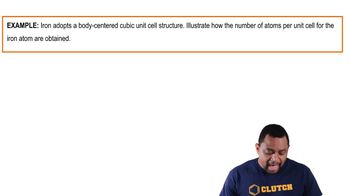A cube-shaped crystal of an alkali metal, 1.62 mm on an edge, was vaporized in a 500.0 mL evacuated flask. The resulting vapor pressure was 12.5 mm Hg at 802 °C. The structure of the solid metal is known to be body-centered cubic. (c) What are the densities of the solid and the vapor in g>cm3?
 Verified step by step guidance
Verified step by step guidance
Verified Solution
Key Concepts
Density

Body-Centered Cubic (BCC) Structure

Vapor Pressure

A group 3A metal has a density of 2.70 g/cm3 and a cubic unit cell with an edge length of 404 pm. Reaction of A 1.07 cm3 chunk of the metal with an excess of hydrochloric acid gives a colorless gas that occupies 4.00 L at 23.0 °C and a pressure of 740 mm Hg. (a) Identify the metal.
A cube-shaped crystal of an alkali metal, 1.62 mm on an edge, was vaporized in a 500.0 mL evacuated flask. The resulting vapor pressure was 12.5 mm Hg at 802 °C. The structure of the solid metal is known to be body-centered cubic. (b) Use the data in Figure 5.19 to identify the alkali metal.
The mineral wustite is a nonstoichiometric iron oxide with the empirical formula FexO, where x is a number slightly less than 1. Wustite can be regarded as an FeO in which some of the Fe sites are vacant. It has a density of 5.75 g>cm3, a cubic unit cell with an edge length of 431 pm, and a facecentered cubic arrangement of oxygen atoms. (c) Each Fe atom in wustite is in either the +2 or the +3 oxidation state. What percent of the Fe atoms are in the +3 oxidation state?
